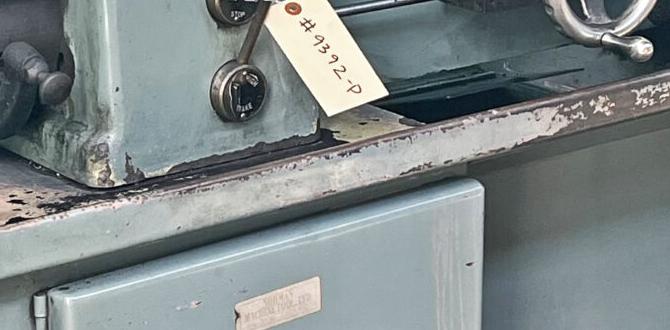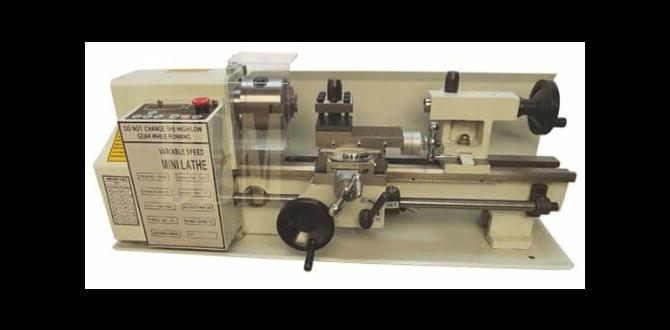This guide simplifies using a 40-degree TiAlN ball nose end mill for wood trochoidal milling. Learn how this specialized tool and technique create smoother, more efficient cuts, reducing tool wear and improving finish quality, even for beginners.
Ever struggled with achieving a smooth finish in your wood milling projects? Or perhaps you’ve found your tools wearing out faster than you’d like? It can be frustrating when your cuts aren’t as clean or efficient as you imagine. Many hobbyists and beginners face these challenges. The good news is there’s a smart way to mill wood more effectively using a specific type of cutting tool. We’re going to break down how a 40-degree TiAlN ball nose end mill can be your secret weapon. We’ll cover exactly what it is, why it works so well, and how to use it step-by-step. Get ready to transform your milling results!
What is a 40-Degree TiAlN Ball Nose End Mill for Wood?
Let’s break down this tool’s name: “carbide ball nose end mill with a 40-degree helix angle and a TiAlN coating.” It sounds complicated, but each part is important for how it cuts wood effectively. This isn’t your everyday router bit;it’s a specialized tool designed for advanced milling techniques.
The Components Explained:
- Carbide: This is the material the cutting edges are made from. Carbide is super hard and strong, meaning it can cut through tough materials and last a long time. For wood, it gives you clean cuts and holds its sharpness really well.
- Ball Nose: This refers to the shape of the cutting tip. Instead of a flat tip like many end mills, a ball nose is rounded, like half a sphere. This shape is crucial for creating smooth, curved surfaces and for techniques like trochoidal milling.
- 40-Degree Helix Angle: This is about the angle of the cutting flutes (the spiral grooves that go around the tool). A 40-degree angle is a bit steeper than some standard end mills. This steeper angle helps “lift” chips away from the cut, leading to a cleaner surface and preventing the tool from overheating or getting clogged up.
- TiAlN Coating (Titanium Aluminum Nitride): This is a super-thin, extremely hard coating applied to the carbide. TiAlN is fantastic for reducing friction and heat. While often associated with metal cutting, it offers significant benefits for wood too, especially in high-speed or demanding applications, by increasing tool life and preventing resin buildup.
When you put all these features together, you get a cutting tool that’s robust, precise, and built for demanding milling tasks in wood.
Why Use Trochoidal Milling with This Tool?
Trochoidal milling is a modern machining strategy that is incredibly effective for certain types of cuts, especially in pockets and contours. When you combine it with a 40-degree TiAlN ball nose end mill, you unlock some serious advantages for woodworking.
Understanding Trochoidal Milling
Imagine a regular end mill plunging straight down into a material. It removes a lot of material in one go, generating a lot of heat and putting stress on the tool. Trochoidal milling is different. Instead of a direct plunge, the tool moves in a continuous, looping, or “epicycloidal” path. This path looks a bit like a series of overlapping circles or ovals.
Key Benefits of the Trochoidal Path
- Reduced Heat Buildup: The tool is constantly moving and not dwelling in one spot. This means less heat is generated in any one area, which is great for preventing burning and extending tool life.
- Efficient Chip Evacuation: The looping motion combined with the helix angle helps to continuously clear chips away from the cutting zone. This prevents chips from packing up, which can cause tool breakage or poor surface finish.
- Constant Tool Engagement: The tool is always cutting, but the depth of cut is significantly shallower than a traditional plunge. This keeps the tool engaged in a more consistent manner, leading to smoother cutting action.
- Ability to Cut Deep Pockets: Because the depth of cut is controlled and chip evacuation is excellent, you can mill relatively deep pockets without needing multiple, slow passes with a large diameter end mill.
Why the 40-Degree Ball Nose is Ideal for Trochoidal Milling in Wood
The specific design of the 40-degree TiAlN ball nose end mill is perfectly suited for this type of milling:
- Ball Nose Shape: Essential for creating smooth, continuous paths. It allows the tool to move seamlessly through its looping motion without creating sharp corners or notches in the cut. It’s also great for creating fillets and rounded internal corners.
- 40-Degree Helix Angle: This provides aggressive chip control. As the tool moves in its trochoidal path, the helix angle actively helps to push the chips out of the pocket. This is critical for preventing buildup in wood, especially with dust-producing materials.
- TiAlN Coating: Wood can be quite abrasive and also contains resins that can build up on cutting tools. The TiAlN coating minimizes friction and adhesion, keeping the tool cleaner and sharper for longer, even when running at higher speeds required for efficient trochoidal milling. This coating is often found on high-performance tools for metal, but its ability to shed heat and prevent material buildup makes it a valuable upgrade for demanding wood cutting.
In essence, this tool and technique work together to create cleaner cuts, reduce stress on your machine and the tool, and improve the overall quality and efficiency of your wood milling operations.
Step-by-Step Guide to Trochoidal Milling Wood
Ready to put this into practice? Trochoidal milling requires careful setup in your CAM software (Computer-Aided Manufacturing) or CNC controller, but the concept is straightforward. Here’s how to approach it.
Step 1: Design Your Part and Toolpath Strategy
First, you’ll need your design in CAD (Computer-Aided Design) software. Then, you’ll import that into your CAM software. For trochoidal milling, you’ll typically use this for clearing out pockets or large profiles. You’ll select a finishing pass strategy if you need a perfectly smooth surface, as trochoidal milling is more about efficient material removal.
Step 2: Select Your 40-Degree TiAlN Ball Nose End Mill
Choose the right diameter for your ball nose end mill. For trochoidal milling, it’s often recommended to use a smaller diameter tool than you might traditionally use for a pocket, as the strategy relies on the tool’s ability to maintain a small radial stepover. Ensure it’s compatible with your CNC machine’s collet system.
Step 3: Configure Your CAM Software for Trochoidal Milling
This is where the magic happens. Most modern CAM packages have a specific “trochoidal milling” or “dynamic milling” strategy. You’ll need to input several parameters:
- Tool Selection: Choose your 40-degree TiAlN ball nose end mill from your tool library.
- Stepover (Radial): This is the distance the tool moves sideways on each loop. For efficient trochoidal milling, this is typically a small percentage of the tool’s diameter, often between 10% and 40%. A smaller stepover means more loops but generally a smoother cut and less tool load.
- Stepdown (Axial): This is how much the tool drops deeper into the material on each full pass around the entire pocket. For trochoidal milling, you can take much larger stepdowns than with conventional milling because of the excellent chip evacuation. Values from 0.5 to 1.5 times the tool diameter are common, depending on the wood’s hardness and machine rigidity.
- Step Angle: This parameter is sometimes associated with the “look” of the trochoid path. You might set this to a value that creates small, overlapping circles.
- Plunge Settings: While trochoidal milling is about efficient lateral movement, you still need to get the tool into the material. You can often use a specialized helical or ramping plunge motion programmed by the CAM software.
- Feed Rates: This is crucial. Because you’re taking lighter, more consistent cuts, you can often run the spindle at higher RPMs and adjust your feed rate accordingly. Refer to your end mill manufacturer’s recommendations and experiment.
Step 4: Set Up Your Workpiece and Machine
- Secure Your Material: Make sure your wood workpiece is clamped down very securely to your CNC machine’s bed. Any movement can ruin the cut and be dangerous.
- Fixturing: Use appropriate clamps or hold-downs that won’t interfere with the cutting tool’s path.
- Dust Collection: Essential for wood! Ensure your dust collection system is turned on and effectively removing chips and dust from the work area. This is VITAL for good results with trochoidal milling.
Step 5: Run a Test Cut (Highly Recommended!)
Before running the full program on your final material, it’s always a good idea to test the toolpath on a scrap piece of the same wood. This allows you to:
- Verify your CAM settings.
- Check for air cuts (where the tool is moving in the air unnecessarily).
- Listen to the sound of the cut – it should be a consistent, relatively high-pitched hum, not a grinding or chattering noise.
- Inspect the chip evacuation.
- Check the surface finish and dimensions.
Step 6: Execute the Milling Operation
Once you’re confident with your test cut, you can run the program on your actual workpiece. Stay near the machine, especially during the first few passes, and be ready to pause or stop the machine if anything seems wrong. Listen for unusual noises.
Step 7: Inspect Your Results
After the milling is complete, carefully inspect the cut. You should see:
- A clean pocket with smooth sides.
- Minimal evidence of burning or scorching.
- Accurate dimensions.
- The ball nose shape will have created nice, rounded internal corners where it followed its path.
This systematic approach ensures you’re using the tool and technique correctly, leading to successful and high-quality milled parts.
When to Use this Tool & Technique
The 40-degree TiAlN ball nose end mill and trochoidal milling aren’t always the best choice for every wood cutting task. They shine in specific situations that leverage their unique advantages.
Ideal Applications:
- High-Speed Machining (HSM): When you want to cut faster and more efficiently, this combination allows for higher spindle speeds and feed rates without overloading the tool.
- Cutting Hardwoods: Dense hardwoods can be tough on tools. The efficient chip evacuation and reduced heat from trochoidal milling help prevent burning and extend tool life in these materials.
- Achieving Smooth Contours and Pockets: The ball nose shape is naturally suited for creating curved surfaces. Trochoidal milling allows these smooth paths to be generated efficiently, especially in internal corners where a standard straight end mill would leave sharp edges.
- Minimizing Tool Wear and Breakage: For intricate designs or long milling jobs, the gentler, more consistent cutting action of trochoidal milling can significantly reduce the stress on your end mill, leading to a longer tool life and fewer accidental breakages.
- Material Removal in Confined Areas: When you need to clear out a lot of material from a small or intricate pocket, trochoidal milling is far more efficient and safer than traditional plunging methods.
- Projects Requiring High Surface Finish: While trochoidal milling is primarily for roughing or semi-finishing, the smooth, consistent cut it produces can be a great starting point for a final sanding or finishing pass.
When to Consider Alternatives:
- Simple 2D Profile Cuts: For cutting out the perimeter of a simple shape, a standard straight or compression bit might be more straightforward and just as effective.
- Very Soft Woods or Foam: In extremely soft materials, less specialized tooling might suffice, and the benefits of the specialized coating and angle might be less pronounced.
- When Tooling Cost is a Major Factor and Volume is Low: The specialized nature of a TiAlN coated ball nose end mill can make it more expensive. For one-off, simple projects, a standard carbide bit might be more economical.
- Machines Lacking Spindle Speed Control: Trochoidal milling often benefits from higher RPMs. If your machine has a limited speed range, you might not see the full advantage.
Understanding these scenarios helps you make the best tooling choices for your projects, ensuring you get the most out of your CNC machine and cutting tools.
Choosing the Right 40-Degree TiAlN Ball Nose End Mill
Not all 40-degree TiAlN ball nose end mills are created equal. When you’re selecting one for woodworking, keep these factors in mind:
Key Considerations:
- Diameter: This is crucial and depends on the detail of your project and the size of the pockets you’re clearing. Common diameters range from 1/8″ to 1/2″. Smaller diameters are great for intricate details, while larger ones clear material faster.
- Flute Count: For wood, 2-flute or 3-flute end mills are common.
- 2-Flute: Generally offers better chip clearance and can run at higher speeds, making it ideal for plastics and softer woods.
- 3-Flute: Can handle heavier cuts and generally provides a smoother finish than a 2-flute, suitable for harder woods.
- Shank Diameter: Ensure it matches your CNC router’s collet size (e.g., 1/4″, 1/2″, 8mm, 12mm).
- Coating Thickness and Quality: A good quality TiAlN coating will be uniformly applied and should offer excellent lubricity and heat resistance.
- Brand Reputation: Stick with reputable tool manufacturers who specialize in cutting tools. They often provide better quality control and more accurate specifications.
- Material it’s designed for: While we’re focusing on wood, some TiAlN coated tools are strictly for metal. Ensure the manufacturer states it’s suitable for wood or composite materials. Some manufacturers offer specific versions with modified flute geometry for wood.
Where to Buy
You can find these specialized end mills at:
- Online Tool Retailers: Websites like Amazon, eBay (be cautious with unbranded items), and dedicated CNC tooling suppliers offer a wide selection.
- Specialty Machining Tool Suppliers: Companies focused on industrial or hobbyist machining tools are a great source.
- Woodworking CNC Specialty Stores: Some stores cater specifically to CNC woodworkers and carry the right types of tooling.
Always check product reviews and descriptions carefully to ensure you’re getting a tool appropriate for wood and compatible with your machine. Investing in a quality tool will pay dividends in performance and longevity.
Maintenance and Safety Tips
Even the best tools require care. Proper maintenance and a focus on safety will ensure your success and longevity with your 40-degree TiAlN ball nose end mill.
Maintenance:
- Clean After Use: Always clean your end mill thoroughly after each use. Wood dust and resin can build up. A stiff brush, compressed air, and perhaps a bit of denatured alcohol can help keep them pristine.
- Inspect for Wear: Regularly check the cutting edges for any signs of chipping, premature wear, or dullness. If you notice a decline in cut quality, it’s time to replace or sharpen the tool (though sharpening carbide end mills is often best left to professionals).
- Proper Storage: Store your end mills in a protective case or bit organizer. This prevents them from banging against other tools, which can damage the cutting edges. Keep them in a dry environment to prevent corrosion.
- Collet Care: Ensure your collet is clean and free of debris before inserting the end mill. A dirty collet can lead to runout (the tool wobbling) and poor cut quality.
Safety:
- Always Wear Safety Glasses: Wood dust, chips, and potential tool breakage are serious hazards. Protect your eyes at all times when operating a CNC machine.
- Use Hearing Protection: CNC machines can be loud, especially during aggressive cutting.
- Ensure Secure Workholding: Make absolutely sure your workpiece is firmly clamped to the machine bed. A loose workpiece can shift during operation, leading to ruined parts, broken tools, or dangerous situations.
- Dust Collection is Paramount: Always have your dust collection system running at full capacity when machining wood. This not only keeps your workspace cleaner but also reduces the risk of respiratory issues and potential fire hazards from fine wood dust. Refer to resources like the OSHA regulations on combustible dust for more information on controlling hazards.
- Know Your E-Stop: Be familiar with the location and function of your CNC machine’s







